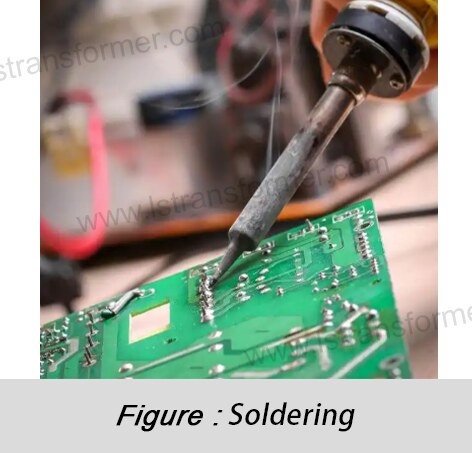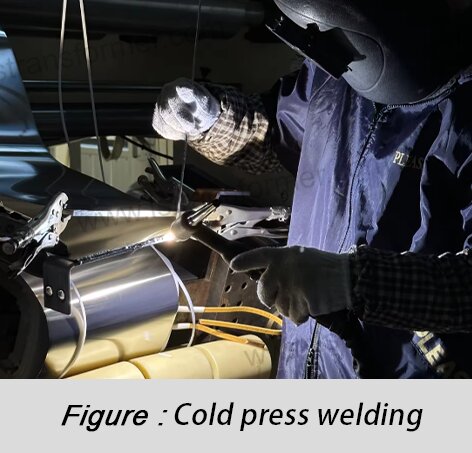Was ist zuverlässiger: Laserschweißen, Löten oder Kaltcrimpen? – Ein Vergleich der Wicklungsdraht-Verbindungsverfahren
Was ist zuverlässiger: Laserschweißen, Löten oder Kaltcrimpen?
—Ein Vergleich der Wicklungsdrahtverbindungsverfahren
Bei der Herstellung von Transformatoren und Drosseln wirkt sich die Wahl des Fügeverfahrens direkt auf die Effizienz, Lebensdauer und Ausfallrate der Geräte aus. Laserschweißen, Löten und Kaltcrimpen weisen erhebliche Unterschiede hinsichtlich Leitfähigkeit, mechanischer Festigkeit und thermischer Stabilität auf. Jede Methode birgt zudem potenzielle Ausfallrisiken, die sorgfältig geprüft werden müssen. Beispielsweise kann die Wärmeeinflusszone (WEZ) beim Laserschweißen eine ungleichmäßige Hochfrequenzstromverteilung verursachen, der niedrige Schmelzpunkt des Lötens kann bei Überlastung zu sekundären Kurzschlüssen führen und Mikrohohlräume beim Kaltcrimpen können den Kontaktwiderstand mit der Zeit erhöhen. Dieser Artikel vergleicht die wichtigsten Kennzahlen und Ausfallfolgen dieser Verfahren unter Bezugnahme auf internationale Normen (IEC 60076, IEEE C57.12.00), um Auswahlrichtlinien für hochzuverlässige Anwendungen bereitzustellen.
Inhalt
1. Leitfähigkeitsvergleich
● Laserschweißen
Die metallurgische Verbindung beim Laserschweißen bietet eine Leitfähigkeit, die der des Grundmaterials nahekommt. Eine Kornvergröberung in der Wärmeeinflusszone (WEZ) kann jedoch den lokalen Widerstand erhöhen. Bei Hochfrequenztransformatoren verstärkt diese mikroskopische Ungleichmäßigkeit den Skin-Effekt, was zu lokaler Überhitzung und beschleunigter Karbonisierung der Isolierung führt. Eine Studie (IEEE Transactions on Power Delivery) zeigte beispielsweise, dass Widerstandsschwankungen in der WEZ die Hochfrequenzverluste um 5 bis 8 % erhöhen können.
● Löten
Beim Löten werden Legierungen verwendet, deren spezifischer Widerstand etwa sechsmal höher ist als der von Kupfer. Schlimmer noch: Oxidation des Lötmittels und thermische Ermüdungsrisse können den Kontaktwiderstand zunehmend erhöhen. In einem Fall (EPRI-Bericht) stieg der Kontaktwiderstand einer Lötstelle in einem ölgefüllten Transformator innerhalb von drei Jahren um 30 %. Grund dafür war das Kriechen des Lötmittels bei 120 °C, was schließlich zum Durchbrennen der Wicklung führte.
● Kaltcrimpen
Kaltcrimpen vermeidet thermische Schäden durch mechanische Kompression, allerdings können Mikrohohlräume bei Stromfluss Mikrolichtbögen erzeugen, und Oxidation kann den Kontaktwiderstand allmählich erhöhen. NASA-Forschungen haben ergeben, dass unbeschichtete Kaltcrimps in extremen Weltraumtemperaturzyklen über ein Jahrzehnt hinweg einen Widerstandsanstieg von 15 bis 20 % aufwiesen.
Prozess | Anfangswiderstand | Primärer Abbaumechanismus | Typische Folgen |
Laserschweißen | ~1.68×10⁻⁸ Ω·m | HAZ-Kornvergröberung | Hochfrequenz-Hotspots, Isolationsalterung |
Lötung | ~10⁻⁷ Ω·m | Oxidation/Kriechen/thermische Ermüdung | Überhitzung, sekundäre Kurzschlüsse |
Kaltcrimpen | ~2×10⁻⁸ Ω·m | Mikrohohlraumoxidation | Kontaktwiderstandsdrift, Mikrolichtbögen |
Tabelle 1: Vergleich von Leitfähigkeit und Langzeitrisiko
2. Vergleich der mechanischen Festigkeit
● Laserschweißen
Zwar kann durch Laserschweißen 90 % der Festigkeit des Grundmaterials erreicht werden, doch Eigenspannungen und Versprödung in der Wärmeeinflusszone verkürzen die Lebensdauer. Ein Transformatorgehäuse einer Windkraftanlage (Wind Energy Journal) zeigte nach acht Jahren Vibration Ermüdungsrisse in der Wärmeeinflusszone, die zu Wicklungsbrüchen führten.
● Löten
Löten bietet die geringste mechanische Festigkeit (30–50 MPa), und thermische Zyklenbelastung kann zu Rissen in den Verbindungen führen. Daten aus Automobilreaktoren zeigten, dass Lötverbindungen nach 2,000 Temperaturzyklen (-40 °C bis 125 °C) versagten, während Laserschweißnähte über 5,000 Zyklen standhielten.
● Kaltcrimpen
Die Festigkeit beim Kaltcrimpen hängt von der Kompressionsrate ab. Zu starkes Crimpen kann jedoch die Drahtfasern durchtrennen und die Verbindung schwächen. Branchenstatistiken (ICEA S-97-682) zeigen, dass 12 % der Feldausfälle auf unzureichende Kompression aufgrund von Matrizenverschleiß zurückzuführen sind.
3. Vergleich der thermischen Stabilität
● Laserschweißen
Laserschweißungen haben den gleichen Schmelzpunkt wie das Grundmaterial (Kupfer: 1083 °C), aber schnelles Abkühlen kann spröde Phasen erzeugen. Eine Fehleranalyse an Hochgeschwindigkeits-Bahntransformatoren (EN 50329) führte den spröden Bruch auf eine übermäßige Schweißnahthärte unter Kurzschlusskräften zurück.
● Löten
Der größte Nachteil des Lötens ist der niedrige Schmelzpunkt. In UL-Zertifizierungstests erweichte bleifreies Lot (SAC305) bei 217 °C, was bei 150 % Überlast zu Kurzschlüssen zwischen den Windungen führte.
● Kaltcrimpen
Obwohl sie hitzebeständig sind, verringert sich durch Spannungsrelaxation mit der Zeit der Kontaktdruck. ASTM B542-Tests zeigten einen Rückgang der Crimpkraft bei Kupferklemmen um 18 % nach 1,000 Stunden bei 150 °C, was zum Ausgleich elastische Dichtungen erforderlich machte.
Richtlinien zur Prozessauswahl
Anwendungsszenario | Empfohlener Prozess | Wichtige Maßnahmen zur Risikominderung |
Hochfrequenz/Hochtemperatur (z. B. Luft- und Raumfahrt) | Laserschweißen | Argonabschirmung zur Reduzierung der Oxidation, Wärmebehandlung nach dem Schweißen |
Kostengünstige/seltene Reparaturen | Lötung | Hochsilberhaltiges Lot (Sn96Ag4), mechanische Verstärkung |
Leistungstransformatoren in Massenproduktion | Kaltcrimpen | Versilberung, regelmäßige Matrizenkalibrierung |
Zusammenfassend
Laserschweißen, Löten und Kaltcrimpen bieten jeweils unterschiedliche Vorteile für das Verbinden von Wicklungsdrähten. Laserschweißen zeichnet sich durch hervorragende Leitfähigkeit und mechanische Festigkeit aus und eignet sich daher ideal für hochzuverlässige Anwendungen wie Hochfrequenz- oder Hochtemperaturumgebungen, wobei die Kontrolle der Wärmeeinflusszone entscheidend ist. Löten ist kostengünstig und einfach durchzuführen, eignet sich jedoch aufgrund seines niedrigen Schmelzpunkts und des Oxidationsrisikos nur für Niederfrequenz- und Niedrigleistungsanwendungen sowie für temporäre Reparaturen. Kaltcrimpen bietet das beste Verhältnis von Kosten und Stabilität für die Massenproduktion, vorausgesetzt, Versilberung und Matrizenwartung berücksichtigen Probleme mit Mikrohohlräumen und Spannungsrelaxation. Zukünftige Fortschritte, wie IoT-basierte Widerstandsüberwachung und hybrides laserunterstütztes Crimpen, können die Zuverlässigkeit und Anpassungsfähigkeit der Transformatorherstellung weiter verbessern.
Kontakt
LuShan, Europäische Sommerzeit.1975, ist ein chinesischer professioneller Hersteller, der sich seit über 50 Jahren auf Leistungstransformatoren und Reaktoren spezialisiert hat. Führende Produkte sindEinphasentransformator, Dreiphasen-Trenntransformator, elektrischer Transformator, Verteilungstransformator, Abwärts- und Aufwärtstransformator, Niederspannungstransformator, Hochspannungstransformator, Steuertransformator, Ringkerntransformator, R-Kern-Transformator; Gleichstrominduktoren, Wechselstromdrosseln, Filterdrosseln, Netz- und Lastdrosseln, Drosseln, Filterdrosseln und Zwischen- und Hochfrequenzprodukte.
Unsere Leistungstransformatoren und Reaktoren werden in zehn Anwendungsbereichen eingesetzt: Schnellverkehr, Baumaschinen, erneuerbare Energien, intelligente Fertigung, medizinische Geräte, Explosionsschutz in Kohlebergwerken, Erregersysteme, Vakuumsintern (Öfen), zentrale Klimaanlagen.
Erfahren Sie mehr über Leistungstransformatoren und Reaktoren:www.lstransformer.com.
Wenn Sie maßgeschneiderte Lösungen für Transformatoren oder Drosseln wünschen, kontaktieren Sie uns bitte.
WhatsApp:+86 17267488565
E-Mail: marketing@hnlsdz.com

 EN
EN
 FR
FR DE
DE ES
ES


